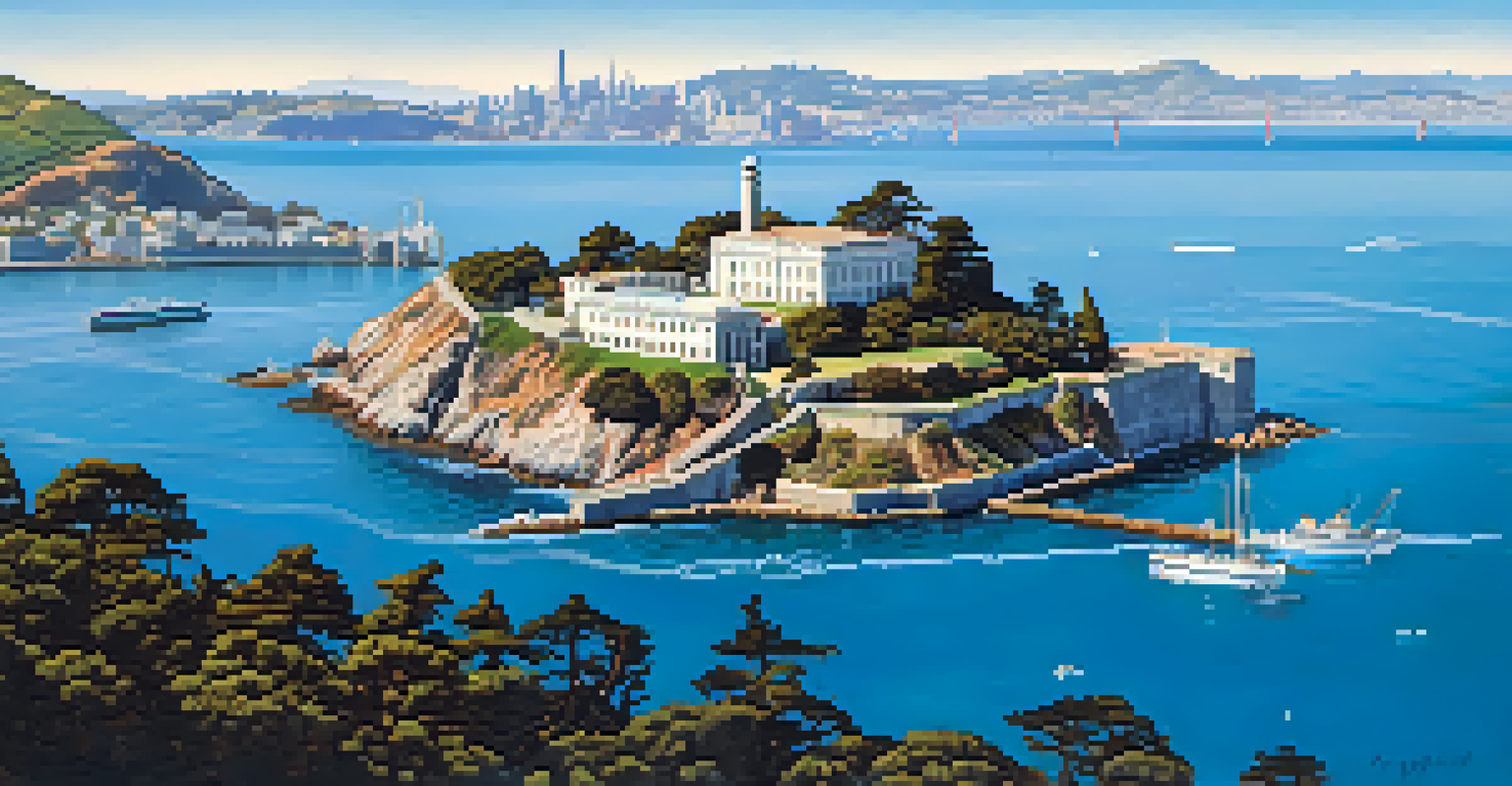Key Historical Landmarks in San Francisco: A Preservation Overview

The Golden Gate Bridge: An Icon of Engineering Excellence
The Golden Gate Bridge stands tall as a symbol of San Francisco, connecting the city to Marin County. Completed in 1937, this monumental piece of engineering was considered a marvel for its time, stretching 1.7 miles across the Golden Gate Strait. Its Art Deco design and International Orange color make it instantly recognizable, attracting millions of visitors each year.
Preservation of the cultural heritage is essential for the future generations to understand and appreciate their past.
Preservation efforts have played a crucial role in maintaining this iconic structure. Over the decades, the bridge has undergone various renovations to protect it from corrosion and the elements, ensuring that it remains safe for pedestrians and vehicles alike. These efforts highlight the importance of blending preservation with modern engineering techniques.
Today, the Golden Gate Bridge is not just a transportation link; it’s a cultural landmark that embodies the spirit of innovation and resilience. Whether viewed from a distance or experienced up close, it serves as a reminder of the city’s rich history and its ability to adapt and thrive.
Alcatraz Island: From Infamous Prison to Historical Site
Alcatraz Island, famously known for its former prison, is steeped in history and intrigue. Once housing notorious criminals like Al Capone, the island has transformed from a high-security penitentiary into a significant historical landmark. Visitors flock to the island to learn about its storied past through engaging tours and exhibits.

Preservation initiatives have been vital in maintaining the integrity of Alcatraz's structures. The National Park Service plays a significant role in ensuring that the remnants of the prison remain intact while providing educational resources for visitors. This balance between preservation and education fosters a deeper appreciation for the island’s history.
Preservation Enhances Cultural Identity
Efforts to preserve historical landmarks in San Francisco play a crucial role in maintaining the city's unique character and cultural identity.
Exploring Alcatraz allows visitors to reflect on themes of justice, rehabilitation, and societal change. Its haunting beauty and rich narratives offer a unique glimpse into the past, making it a poignant reminder of the complexities of American history.
Mission San Francisco de Asís: A Glimpse into California’s Roots
Mission San Francisco de Asís, also known as Mission Dolores, is the oldest surviving structure in San Francisco, founded in 1776. This mission is not just an architectural gem; it represents the early Spanish colonial influence on California’s development. Its beautiful chapel and serene grounds invite visitors to explore the origins of the city.
History is not a burden on the memory but an illumination of the soul.
The preservation of Mission Dolores is a testament to the importance of cultural heritage in urban settings. Ongoing restoration efforts ensure that the mission remains a focal point for education about California’s mission system and early indigenous history. These efforts highlight the significance of maintaining historical structures in a rapidly evolving city.
Visiting Mission Dolores offers a peaceful escape from the bustling city, allowing for reflection on the blending of cultures that shaped San Francisco. It serves as a reminder of the city’s long-standing legacy and the need to honor its diverse history.
The Painted Ladies: Architectural Beauty and Cultural Significance
The Painted Ladies, a row of Victorian houses located across from Alamo Square, are an iconic representation of San Francisco’s architectural diversity. These colorful homes, built in the late 19th century, capture the charm of the era while showcasing the city’s unique style. Their popularity has soared, becoming one of the most photographed locations in the city.
Preservation of the Painted Ladies is crucial in maintaining the character of San Francisco’s neighborhoods. Local organizations and city regulations work together to uphold the integrity of these historic homes, ensuring they remain a cherished part of the city’s landscape. This commitment to preservation helps protect not just the buildings but also the stories they tell.
Landmarks Reflect Rich Historical Narratives
San Francisco's landmarks serve as tangible connections to its diverse past, allowing residents and visitors to explore the stories that shaped the community.
As you stand in front of the Painted Ladies, you can’t help but feel a sense of nostalgia for the past. They embody the spirit of community and continuity, reminding us of the importance of preserving our cultural landmarks for future generations.
The Palace of Fine Arts: A Treasure of Art and Architecture
The Palace of Fine Arts is a stunning architectural masterpiece that originally served as the exhibition hall for the 1915 Panama-Pacific International Exposition. Its Greco-Roman style and picturesque lagoon make it a beloved spot for both locals and tourists. The structure evokes a sense of timeless beauty and serves as a backdrop for countless events and gatherings.
Preservation efforts at the Palace of Fine Arts have been vital in maintaining its grandeur. After facing deterioration over the years, the facility underwent extensive restoration, allowing it to continue as a cultural venue. These efforts have ensured that the palace remains a vibrant part of the San Francisco landscape, celebrating art and community.
Visiting the Palace of Fine Arts offers a moment of tranquility amidst the urban hustle. It stands as a testament to the city’s artistic legacy and the importance of nurturing our cultural institutions.
Chinatown: Preserving a Cultural Heritage
San Francisco's Chinatown is the oldest and largest Chinatown in North America, rich with cultural history and significance. Established in the mid-19th century, it has since become a vibrant community hub, showcasing Chinese traditions, cuisine, and art. The streets are alive with colorful shops, markets, and festivals, making it a must-visit for anyone exploring the city.
Preservation of Chinatown is essential for maintaining its cultural identity amidst modernization. Local initiatives and community organizations work tirelessly to protect historic buildings and promote cultural programs. This dedication helps ensure that Chinatown remains a living testament to the contributions of Chinese immigrants to San Francisco.
Community Engagement in Preservation
Collaboration between government, non-profits, and community members ensures that the preservation of historical sites fosters a sense of belonging and continuity.
Walking through Chinatown, you can feel the pulse of its history and the resilience of its community. It serves as a reminder of the importance of cultural preservation in a diverse urban landscape, fostering both connection and understanding among different cultures.
The Ferry Building: A Gateway to San Francisco’s Maritime History
The Ferry Building has long been a vital transportation hub in San Francisco, connecting the city to various points across the Bay. Built in 1898, its towering clock and beautiful waterfront location make it an iconic landmark. Today, it serves not only as a transportation center but also as a vibrant marketplace filled with local vendors and eateries.
Preservation efforts for the Ferry Building have been essential in maintaining its historical significance while adapting to modern needs. A major restoration completed in 2003 transformed it into a bustling food destination while preserving its architectural integrity. This blend of history and contemporary culture showcases the importance of adaptive reuse in urban environments.

Visiting the Ferry Building offers a taste of San Francisco’s maritime heritage while indulging in culinary delights. It symbolizes the city’s ongoing evolution while honoring its past, making it a treasured part of the San Francisco experience.
The Importance of Preservation in San Francisco’s History
Preservation of historical landmarks is vital in maintaining the unique character of San Francisco. As the city evolves, these landmarks serve as tangible connections to its rich past, reminding residents and visitors alike of the stories that shaped the community. They provide insight into the city’s development and the diverse cultures that have contributed to its identity.
Efforts to preserve these sites often involve collaboration between government agencies, non-profits, and community members. These partnerships ensure that preservation is not just about maintaining structures but also about fostering a sense of belonging and continuity within the community. It’s a collective effort that highlights the value of history in shaping our present and future.
Ultimately, the preservation of San Francisco’s historical landmarks enriches the experience of living and visiting the city. These sites invite exploration and reflection, reinforcing the idea that history is not just a series of events but a living narrative that continues to unfold.